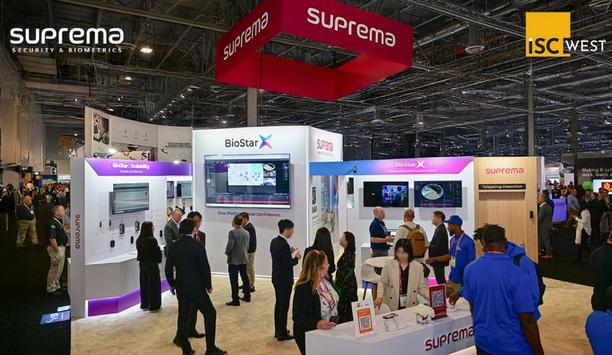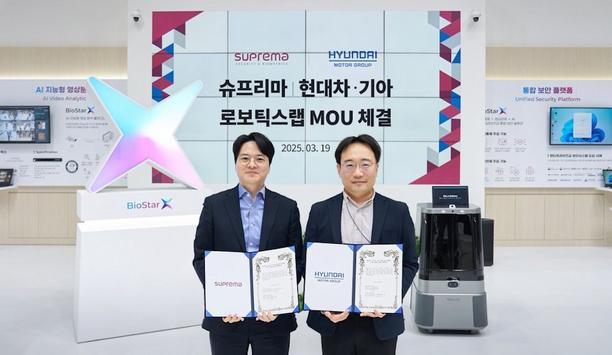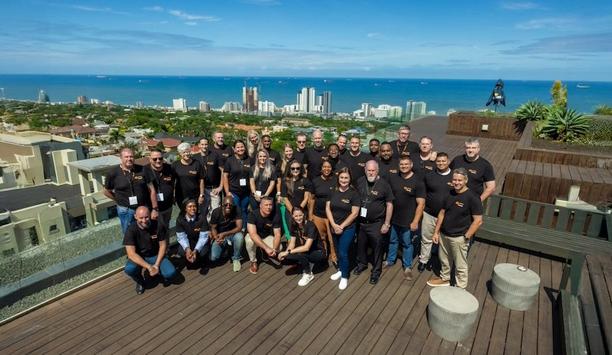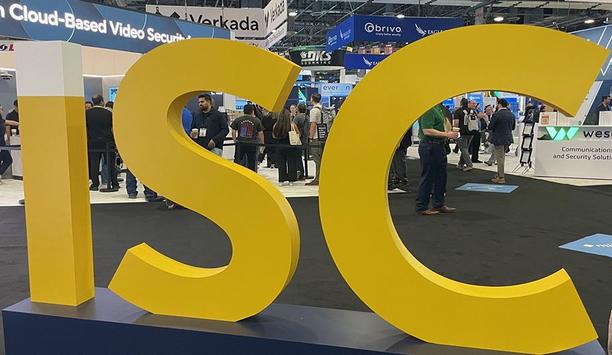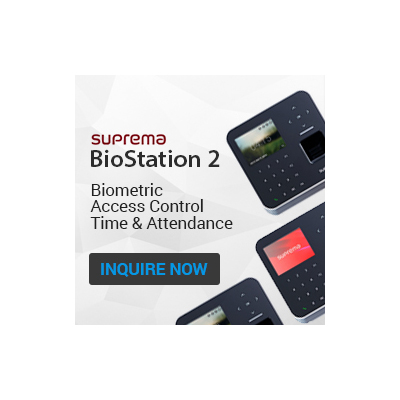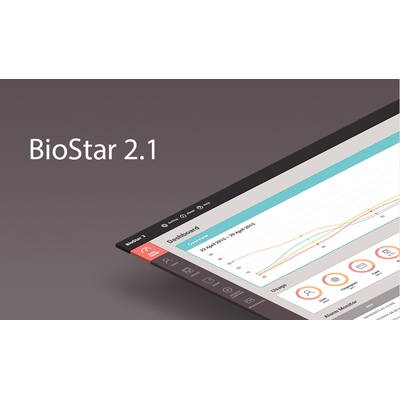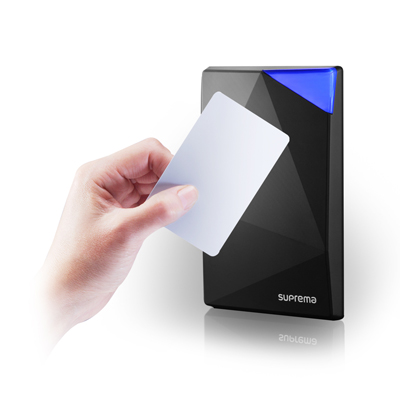Suprema - Experts & Thought Leaders
Latest Suprema news & announcements
Suprema, a global pioneer of AI-based security solutions, will showcase its latest innovations at ISC West 2025, the largest security industry trade show in the United States, taking place in Las Vegas from April 2 to 4. This year, Suprema will launch a range of integrated security technologies tailored to meet the needs of organisations of all sizes. Integrated security platform This integration empowers security teams to effectively manage complex environments The highlight of the showcase will be the global launch of BioStar X, Suprema’s integrated security platform. BioStar X brings access control and video analytics together on a single platform, enabling AI-powered real-time access management, video monitoring, and intelligent video analytics to be performed through one unified dashboard. Smart threat detection This integration empowers security teams to effectively manage complex environments and respond quickly to incidents, even with limited resources. Visitors to the Suprema booth will see demonstrations of BioStar X's advanced abnormal behavior detection and video analytics technologies. Powered by Suprema’s proprietary AI algorithm—winner of the CES 2025 Best of Innovation Award—the platform can detect potential threats such as intrusion, loitering, and falls. It also detects tailgating attempts in real-time, instantly alerting security personnel through the dashboard for rapid response. Smart security solutions The BioStar X dashboard is highly intuitive and configurable, featuring real-time video monitoring The BioStar X dashboard is highly intuitive and configurable, featuring real-time video monitoring, access logs, building maps, and one-click action trigger buttons—enabling optimised and efficient security management customised to user needs. Supporting tens of thousands of users and over 5,000 connected devices, the platform is ideal for large, multi-use facilities such as airports, hospitals, and government institutions. Alongside BioStar X, Suprema will showcase BioStar Air, a cloud-based access control system that allows organisations to build a state-of-the-art security infrastructure without the need for on-premise servers. Flexible access solutions With its high scalability and flexibility, BioStar Air is particularly suited for small businesses and multi-tenant environments. It supports a wide range of authentication methods—including AI-powered biometric authentication, mobile access, QR codes, and RFID—allowing businesses to choose their method to specific operational requirements while enhancing both security and user convenience. AI-powered innovation Suprema will demonstrate seamless system integration with major global security solution providers It also enables remote management from any location, anytime, via mobile or desktop, further improving operational efficiency without geographical constraints. Suprema will also introduce CoreStation 20, a new 2-door controller designed for cost-effective and scalable deployment. CoreStation 20 supports easy installation and flexible architecture, offering robust encryption and uninterrupted operation even during network outages—ensuring high security and reliability. Furthermore, Suprema will demonstrate seamless system integration with major global security solution providers, including Verkada, Genetec, Gallagher, and Software House, offering broader compatibility. This strengthens Suprema’s ability to deliver optimised security solutions for diverse environments and solidifies its presence in the North American market. AI-powered innovation “We are excited to present our AI and cloud-driven innovations at ISC West 2025, aligned with evolving market demands. Our in-house developed AI—recognised with the CES 2025 Best of Innovation Award—elevated both security and convenience of our solutions," stated Bob McKee, President of Suprema America, "We believe this advancement will help our customers to build safer and more efficient security environments. Going forward, Suprema will continue to drive innovation and expand its presence in the North American market through cutting-edge technology and global partnerships.”
Suprema, a pioneer in AI-powered biometric and security solutions, announced the signing of a Memorandum of Understanding (MOU) with Hyundai Motor Group. This partnership will focus on the development of AI and robotics-based total security solutions. This agreement aims to create innovative business models in robotics and physical security by combining Suprema’s globally pioneering AI-based integrated security solutions with Hyundai Motor Group Robotics LAB’s advanced robotics technology. New security services The implementation of autonomous robot services by connecting robots with infrastructure The key areas of cooperation between the two companies will include the development of total security solutions that integrate AI and robotics, the implementation of autonomous robot services by connecting robots with infrastructure, the development of new security services utilising robotics technology, and the promotion of standardisation in these fields. The collaboration is expected to lead to the commercialisation of next-generation AI-based building security services that combine AI security and robotics. Suprema’s AI-based integrated security platform These solutions will be applied to a variety of robot-friendly building projects, including prime office buildings, general hospitals, and luxury hotels. Suprema’s AI-based integrated security platform will have the capability to control security and infrastructure across entire buildings, creating an environment where humans and robots can safely coexist. This will enable the autonomous navigation of robots and provide a range of robot-friendly building services. Suprema’s AI-based facial authentication The companies plan to focus on the continued growth of new security services Together, Suprema and Hyundai Motor Group Robotics LAB have already successfully developed and deployed a security solution that integrates Suprema’s AI-based facial authentication access control technology with autonomous robots at Factorial Seongsu, Korea’s first commercialised robot-friendly building. Building on this success, the companies plan to focus on the continued development of new security services. This includes the implementation of specialised security form factors using robotics hardware and software technologies to further enhance physical security. New era of unmanned security services “This partnership marks a significant milestone as we open a new era of unmanned security services that integrate AI and robotics. We plan to expand our collaboration with Hyundai Motor Group Robotics LAB to develop AI-driven, robot-friendly building security solutions,” said Hanchul Kim, CEO of Suprema Inc. “Our system will seamlessly integrate cloud technology, robotics, AI, various sensors, and on-site response solutions. Furthermore, we aim to establish ourselves as a global pioneer in integrated security platforms featuring AI-driven automation, including advanced technologies such as AI drones and acoustic detection systems.” Integration with access control solutions “Access control serves a critical function in developing intelligent robot-friendly spaces. Through integration with access control solutions, we will propose a new industry standard in which robots with humans overcome infrastructural issues and take advantage of greater mobility and seamless services,” said Dong Jin Hyun, Hyundai Motor Group Vice President and Head of Robotics LAB. “We aim to expand offerings beyond the existing static form factors within the physical security industry and create new business opportunities through Robotics LAB’s RTS (Robotics Total Solution) model.”
Award-winning security manufacturer, Gallagher Security is reflecting on the success of its recent Integrate 360 event held in Durban, South Africa. Held at Premiere Splendid Inn Umhlanga, Durban on February 20, the event attracted 65 Channel Partners, End Users, and consultants from across KwaZulu-Natal and wider South Africa to showcase the latest in Gallagher’s innovative technology suite, discuss features and solutions ear marked for the future, and gain insights into the wider security industry, and key trends for the year ahead. Latest innovations and integrations The event provided a total agenda, including learning sessions, displays, live demonstrations Gallagher was joined by a number of their pioneering Technology Partners including ATG Digital, CathexisVision, HID, RunRite Electronics, Stratus Technologies, Suprema, Traka/Assa Abloy, and Turnstar Systems who shared their latest innovations and integrations with Gallagher with attendees. The event provided a comprehensive agenda including knowledge sessions, presentations, live demonstrations and valuable networking opportunities for attendees. Discussions on the future of the security industry Gallagher Security South Africa, Group Operating Officer, Morne Grobler says, “This year’s Integrate 360 event was another success and a highlight of our annual event’s calendar. We value every opportunity to come together with our Channel Partners, End Users, consultants, and members of the wider security industry to share insights, network and participate in meaningful discussions on the future of the security industry.” He adds, “Investing the time to connect with our industry peers and build relationships is a powerful step towards strengthening our regional activity and continuing to unlock even greater value for our customers through the power of our people and our solutions.”
Insights & Opinions from thought leaders at Suprema
ISC West 2025 in Las Vegas showcased the latest advancements in security technology, offering security professionals a glimpse into the future of the industry. This year's expo highlighted the growing influence of artificial intelligence (AI), cloud computing, and enhanced integration. The pioneering comprehensive and converged security event attracted nearly 29,000 industry professionals to the Venetian Convention Centre. Integration into unified platforms Several companies emphasised the importance of cloud-based solutions and the integration of diverse security components into unified platforms. For example, Brivo's Security Suite provides “everything in one platform” – not just access control. Customers only pay for what they use because the system is flexible and scalable from a single door to enterprise level applications. Brivo’s suite includes video, but the system can also tie in with third-party “partners.” Genetec's Security Centre allows for more frequent updates through the cloud. Milestone is undergoing a two-year transition to bring its Xprotect system into the future by incorporating Arcules and Briefcam into a video-as-a service product. Suprema introduced BioStar X, which integrates access control and video analytics into a single platform. AI and mobile credentials Axis Communications’ Cloud Connect product announced three new partnerships at ISC West 2025 Axis Communications’ Cloud Connect product announced three new partnerships at ISC West – Eagle Eye Networks, SecuriThings, and Wesco. They join the three partners announced during the first year of Axis Cloud Connect – Genetec, Kone (elevators) and Milestone. AI and mobile credentials were still hot topics at ISC West 2025, but the conversation has evolved beyond amazement at the technologies’ capabilities and now centres on more practical aspects. From the theoretical to the practical “AI and mobility are still the ‘flavors de jour,’ but messages are evolving to manifest AI for better outcomes,” says Heather Torrey, General Manager, Commercial Security, Americas, for Honeywell Building Automation. The company has reframed its security portfolio to be very building- and business-focused, continuing to grow and evolve after the recent acquisition of LenelS2. “From the theoretical to the practical, we want customers to be part of the conversation so we can deliver AI that is meaningful to them, focusing on what’s most important,” says Torrey. Under Honeywell’s new ownership structure, “each part of the business can be more focused on customers’ needs,” she says. Honeywell continues its journey around mobile access and credentialing and migrating to cloud solutions. Innovations in Access Control Gallagher’s new Quickswitch access control board simplifies the migration from legacy systems Access control remains a critical component of security systems, and ISC West 2025 showcased several innovations in this area. Acre is releasing “Gallery,” its version of the App Store for access control. DormaKaba is launching the Keyscan KC Series door controller with TCP/IP connectivity and enhanced features. Gallagher’s new Quickswitch access control board simplifies the migration from legacy systems. Johnson Controls highlighted its C-Cure command centre and C-Cure IQ web client, offering a unified approach to access control and video. Hardware integrations for security panels For service provider Alarm.com, hardware products prepare a path to greater customer experiences, says Abe Kinney, Alarm.com’s Director, Product Management, who oversees hardware integrations for security panels, sensors, video, etc., and drives new product development. “We are looking to bridge the physical world to digital world,” he says. “We want to bring an advantage to our dealers that they can bring to customers.” Because Alarm.com’s customers pay a monthly fee, the products must be durable and economical, says Kinney. “It should work with no need for truck rolls.” The importance of longevity and flexibility Products are evaluated based on features, price, and ease of installation Products are evaluated based on features, price, and ease of installation. In particular, longevity is important for the Alarm.com’s pro channel. There is also a growing emphasis on deterrence industrywide. Says Kinney: “We recognise that detection is part of it, but we need to prevent problems from happening in the first place. And the industry is re-evaluating.” When it comes to cloud intelligence, Eagle Eye Networks puts the emphasis on flexibility. They offer AI that can perform anywhere on the system infrastructure, on the camera, on their on-site bridge device, or in the cloud. They support their own AI and also any AI product from a third party. “We focus on what customers want from the data AI detects,” says Hans Kahler, Eagle Eye Networks’ Chief Operating Officer. Integration with other systems A timely alert from gun detection could save a life, but AI can also generate information that might be used and analysed later, such as point-of-sale information, dwell time, foot traffic, etc. “What people want is the ability to work with the data for business intelligence,” says Kahler. Integration with other systems provides new opportunities for customers: For example, a licence plate reader at a restaurant drive-thru could trigger customisation of the menu board digital signage based on the customer’s previous buying pattern. Relentless Innovation Assa Abloy handles more than 40 million SKUs for all its various brands, faked in 28 factories in the US Assa Abloy handles more than 40 million stock keeping units (SKUs) for all its various brands manufactured in 28 factories in the United States. Merely complying with regulations such as the “Buy American Act” is a monumental effort considering the massive product line, attendees heard at Assa Abloy’s Annual ISC West Breakfast focusing on compliance challenges in the security market. Meanwhile, back at the trade show booth, Assa Abloy focused on “relentless innovation” in every corner of its product line. Assa Abloy’s message: Innovation in security does not have to be about AI or automation. In fact, inventive approaches to products come in all shapes and sizes and at every level of the product portfolio, and innovation is happening faster than ever. For example, the Safebolt product from Securitech, a brand recently acquired by Assa Abloy, can quickly lock down existing doors with the press of a red button on a cylindrical or mortise lock. Temporary Systems to Secure Events Securing events is the focus of Allied Universal's Unified Command Solutions, which specialises in setting up temporary security systems for conventions, trade shows, festivals, construction sites, parades, and other events. They can add technology to situations where previously mostly security officers were used, providing safety/security and enabling more efficient event operation. “We can put cameras anywhere, whether they need power or not, use cell service or WiFi, a localised network or the internet, or whatever,” says Andrew LaMadrid, VP, Sales for Allied Universal's Unified Command Solutions. Event operation and management IDIS came to ISC West looking to leverage new products that they did not promote in the past The focus is on easy implementation, flexibility, and fast setup and removal. “We look for a solution to solve each customer’s pain points,” says LaMadrid. They specialise in setting up and deploying surveillance cameras for safety/security and for event operation and management. Mobile surveillance is a relatively new “piece of our puzzle” when it comes to protecting high-profile events. “People are excited about what we can offer that’s new,” says LaMadrid. Unified Command Solutions has been around for about 12 years and was acquired by Allied Universal last summer. IDIS came to ISC West looking to leverage new products that they did not promote in the past, and visitors were very interested in those solutions, says Scott Switzer, IDIS CEO. “The progression of our product line has been tremendous,” he says. Last year, the IDIS booth offered only basic analytics, but this year they had 30 different advanced analytics including gun and aggression detection using the advanced solution “IDIS Vaidio AI.” What Makes You Different? The most common question IDIS hears at their trade show booth is: “What makes you different?” The answer: They offer an end-to-end solution, including cameras; they manage, control, design from end-to-end; and there is no need for multiple integrations. The time needed to install an IDIS system is significantly less because of the simplicity. “We have customers we have supported and grown together for over 20 years,” says Switzer. The company previously deployed IDIS cameras under the Costar brand before the Korean IDIS brand was introduced into the U.S. (IDIS purchased Costar and changed the name to IDIS America.) “This has been a tremendous show for us; we are looking to build our momentum and let more people know about IDIS,” says Switzer. Managing real AI at the edge The depth of their metadata enables new applications, whether for security or business operations Based in Prague, Czech Republic, and with U.S. offices in Pennsylvania, FF Group provides licence plate recognition for harsh environments. Using Axis cameras, they offer “managed real AI at the edge,” selling through a nationwide distributed network, says Alex Osypov, CEO and Founder of FF Group. Markets include parking lots, cities/municipalities, police, government, water systems, etc. The depth of their metadata enables new applications, whether for security or business operations. They are looking to combine and correlate data including LIDAR, RADAR, etc. to exploit the advantages of “data fusion.” Osypov says: “The market is growing because we are involving other adjacent markets.” Unified platforms and advanced tools Several companies are focusing on enhancing security operations centres (SOCs) by providing unified platforms and advanced tools. Axon’s Fusus system “layers” onto existing infrastructure, tying together various sensors into a single interface for real-time monitoring and information sharing. Increasingly, enterprises have invested in a lot of technologies – ac, video, asset trackers – but none of it talks together. Fusus ties all the systems together so that operators no longer have to look at 10 different screens. Rather, there is a “single pane of glass” that shows everything and facilitates sharing of information with law enforcement. Motorola also showcased its Security Operations Centre, which integrates hardware, software, smart sensors, communication radios, and broadband devices to streamline incident management.
Software as a Service (SaaS) provides computer equipment, OS, and software customised to the user’s purposes as a service. Access control can work in the same way. If you work in the physical security industry, especially concerning access control, you have probably heard about the term ‘ACaaS’ recently. ACaaS is a combination of ‘access control’ and ‘SaaS’ (Software as a Service). From a semantic point of view, ACaaS means providing cloud-based access control software as SaaS. Access control software is changing with the trends Cloud systems are mainly classified as IaaS, PaaS, and SaaS. IaaS (Infrastructure as a Service) provides computing equipment and operational support from an external cloud-based service provider. Amazon’s AWS or Microsoft Azure falls under this category. According to their contracts, users can remotely control computing equipment, provided by AWS and Azure. PaaS (Platform as a Service) is the provision by an external service provider of an operating system (OS) and various frameworks required for application development. SaaS goes one step further, providing computing equipment, OS, and on-demand software services that can deliver value quickly. The emergence of SaaS — what are the advantages? Adopting SaaS enables them to receive software services, without having to install and manage by themselves If you are not a developer nor in the software development industry, then what you know as a ‘cloud service’ is probably SaaS. Companies in various industries traditionally build their own infrastructure and purchase expensive software to install on-premises. However, adopting SaaS enables them to receive software services, without having to install and manage by themselves, opting instead to pay a fixed monthly fee and access the software on the cloud. The best example is Salesforce.com, which offers customer relationship management (CRM) as SaaS, and Microsoft Office 365 and Google Workspace, which offer productivity tools as SaaS. Continuous growth of the SaaS market The SaaS market has been continuously growing since 2010. Salesforce.com recorded the largest market share with its CRM SaaS model. At the same time, Microsoft Office 365, a SaaS version of the traditional on-premises Microsoft Office, has surpassed its competition in the productivity software industry. So, what is driving the growth of the SaaS market? On the surface, SaaS is recognised as a means of saving CAPEX and OPEX. However, its actual cost-effectiveness might not be so significant, since the cost of SaaS-based services tends to increase in proportion to the number of users and period of use. SaaS-based services driven by quality of their features What most drives SaaS-based services is the quality of their features, as determined by user satisfaction. In contrast with the on-premises systems of the past, where improvements came too slowly, as people could only provide feedback via email or phone, SaaS allows companies to detect inconveniences directly from the system and quickly respond. Considering the advantages of providing rapid feedback and improvements, SaaS makes a big difference in terms of the quality of features and user satisfaction. SaaS-based cloud services can create new opportunities, by leveraging accumulated data Additionally, SaaS-based cloud services can create new opportunities, by leveraging accumulated data. Using AI-based analysis of data stored in the Cloud helps to provide unprecedented convenience to the market. The best example of this could be Salesforce.com’s Einstein service, which provides an analysis of customers' growth potential or risks. Adopting ACaaS for cyber security ACaaS tries to incorporate all of the above benefits associated with SaaS to access control software ACaaS tries to incorporate all of the above benefits associated with SaaS to access control software. However, the access control industry has been slow to adopt SaaS-based cloud services, when compared to other industries. This is because the life cycle of an access security system extends to around 10 years and many security managers still assume that internal services are safest and external services are unsafe. It is now becoming important to rethink whether it truly is the case that internal systems are safe and external ones are not. For example, consider ‘intranets’, private networks unconnected from external networks, common use until the early 2000s. Digital transformation and remote working We all gathered together in the same place to work in the past. But with the impact of the COVID-19 pandemic and subsequent digital transformation, working environments have changed in various ways and places. Importantly, it is now very uncommon to be cut off from the outside world with an intranet. Modern work and life require a connection to the internet for communication with others and working remotely. In this age where few truly private networks exist, the idea that external services are unsafe may be misguided. SaaS-based ACaaS services The question that matters most from a cyber security perspective is not whether the system is internal or not, but whether the system is really secure. There are many available administrative and technical solutions that secure systems, and many standards, such as ISMS and ISO27001 exist for safer system management. These solutions and standards make a system or service secure. SaaS-based ACaaS services comply with these standards, meaning your systems are protected by numerous experts and specialists. Of course, when selecting a solution, security managers should consider whether the ACaaS is designed for and certified by a standardised security framework. ACaaS — the future of access control systems ACaaS will improve quality, making it more convenient, safe and quickly responding to user feedback Access control software has long been regarded as a complicated matter by security managers. Although it is complex technology by nature, efforts to improve its convenience of usage have fallen short. For this reason, we should pay attention to SaaS, which increases usability. As many SaaS-based cloud services in other industries have shown, ACaaS will improve quality, making it more convenient, safe and quickly responding to user feedback. Furthermore, ACaaS will facilitate the development of safer and more convenient systems, by leveraging AI analysis of accumulated data. Enhanced safety and convenience For example, access control systems may add a feature to identify abnormal behaviours and movements, based on existing access and behavioural data, in order to predict and prevent possible incidents. Just as SaaS-based cloud services in other industries have adopted an unprecedented level of convenience with intelligent new features, ACaaS will also be able to increase convenience and safety for companies and users, with intelligent new features that could not be realised in previous times.
We encounter AI with increasing frequency, both online and in the media. AI has penetrated deep into various aspects of our lives, from TV sets that improve picture quality using AI, or air conditioners with automatic temperature and humidity control, to investment management services that predict return rates. AI technology first appeared in the 1950s and was briefly revived in the 1980s before falling off the radar. In the late 2000s, AI re-emerged and went on to become a key technology and driver in the IT industry. In order to learn and adapt, AI technology required a large amount of data, which was difficult to collect in the pre-2000s. By the late 2000s, things began to change. Large quantities of data began accumulating on the cloud, propelled by the Internet, smart phones, and the emergence of cloud-based services. The emergence of the Internet of Things (IoT) accelerated data collection and has led to explosive growth in AI technology. Data collected through the IoT and smart phones were sent to cloud platforms and used for AI, leading to drastic industrial changes. These industrial changes have been dubbed the "Fourth Industrial Revolution", Industry 4.0. Physical security dilemma For the physical security industry, which handles access control and video surveillance via IT systems, security has always been accompanied by inconvenience and inefficiency. Greater security comes with a greater number of procedures that cause inconvenience and inefficiency for individuals partaking in them. The industry has traditionally opted to enhance security by making thousand of people go through additional steps in order to prevent one person from causing an issue. The challenge for companies and the security industry has long been striking a balance between security enhancement and efficiency. Future changing with Industry 4.0 Industry 4.0 is the key to solving the physical security dilemma. If we can allocate more resources to parts of organisations with higher security risks, or if we can recognise a sign of security error in advance and respond accordingly, then we will be able to enhance security without compromising convenience and efficiency. AI can be used to recognise irregular patterns and isolate parts with a high probability of security breach Smart operations such as these are possible when AI is trained against a large data source. If we can collect access and movement information through access records and the RTLS (Real-time Location System), and train the AI using the access and movement patterns of individuals, the AI can be used to recognise irregular patterns and isolate parts with a high probability of security breach. AI to access the movement patterns We can also use AI to study the access and movement patterns after security incidents occur. This means that further down the line if the same pattern should be detected, the AI can automatically take the appropriate actions to prevent the security breach. These are just some of the possibilities when AI is trained against accurate access, movement and location data, collected in the cloud from access control devices and RTLS devices. RTLS-based location tracking has already been commercialised. This technology is already being used to track patients in larger hospitals and for indoor navigation services in big shopping malls. In addition, access control, which core of the physical security industry, has already moved onto the cloud. The cloud-based access control market is showing a growth rate of 26.8%, three times that of the general access control market. Cloud-based access control service providers including Brivo and Kisi are leading this growth. An Industry 4.0 platform for the physical security industry is already emerging with data being collected for cloud storage and training AI. Inside Industry 4.0 Simply put, the industrial revolution is a change in the way we create exchangeable value, a change in the way we make money. AI trained on big data has already begun to surpass the limitations of human judgment. AI-based cloud service solutions now offer a new value that on-premise solutions based on human judgment simply cannot provide. Industry 4.0 for the physical security industry is still in its infancy, and that’s why the Suprema R&D team is developing cloud-based physical security services that are more convenient, efficient, and secure with the help of AI technology.
Using artificial intelligence (AI) to automate physical security systems
DownloadA modern guide to data loss prevention
Download7 proven solutions for law enforcement key control and asset management
DownloadThe truth behind 9 mobile access myths
DownloadAccess control system planning phase 2
DownloadSuprema BioStation 2 IP fingerprint terminal: New standard in biometric access control and time & attendance
Suprema BioStar 2.1, open security platform, offers improved usability and expandability for users and developers
Suprema Xpass S2 multi-smartcard reader and controller contains enhanced features for IP access control






















